Rea Irvin
Rea Irvin (August 26, 1881—May 28, 1972) was an American graphic artist. Although never formally credited as such, he served de facto as the first art editor of The New Yorker. He created the Eustace Tilley cover portrait and the New Yorker typeface. He first drew Tilley for the cover of the magazine's first issue on February 21, 1925. Tilley appeared annually on the magazine's cover every February until 1994.[1][2] As one commentator has written, "a truly modern bon vivant, Irvin (1881–1972) was also a keen appreciator of the century of his birth. His high regard for both the careful artistry of the past and the gleam of the modern metropolis shines from the very first issue of the magazine ..."[3]
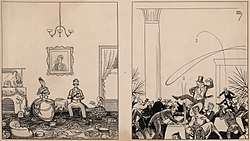
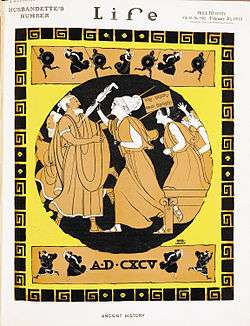
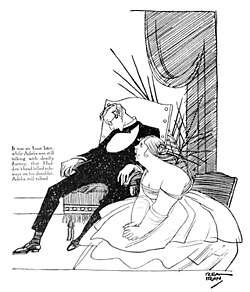
| Rea Irvin | |
|---|---|
| Born | August 26, 1881 San Francisco, United States |
| Died | May 28, 1972 (aged 90) Frederiksted, Saint Croix, U.S. Virgin Islands |
| Nationality | American |
| Area(s) | Illustrator, cartoonist, art editor |
Early career
Born in San Francisco, he studied at the Mark Hopkins Art Institute for six months, started his career as an unpaid cartoonist for The San Francisco Examiner.[4] He also contributed to the San Francisco Evening Post. He also worked as an itinerant actor (for both stage and screen), newspaper illustrator, and piano player.[3] In 1906 he moved to the East Coast. In the 1910s he contributed many illustrations to both Red Book magazine and its sister publication, Green Book.[4]
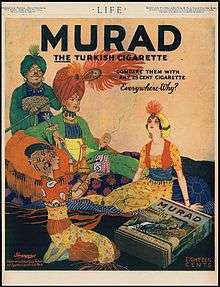
Before World War I, Irvin contributed illustrations regularly to Life, and rose to the position of art editor. (Life the humorous weekly, and not to be confused with the more famous magazine of the same name published by Henry Luce). Irvin also contributed to Cosmopolitan when it was a serious literary publication. He illustrated Wallace Irwin's "Letters of a Japanese Schoolboy" in Life.[5] He would later incorporate Japanese imagery in satirical kakemono for The New Yorker.[5]
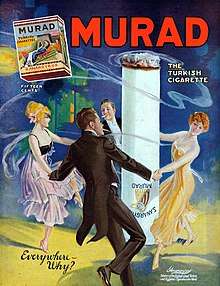
He also created a series of humorous advertisements for Murad (turkish tobacco cigarettes).[5]
He was fired from his position as art editor at Life in 1924.
He also contributed the illustrations for "Snoot If You Must," by Lucius Beebe, a noted raconteur of New York's cafe society (1943, D. Appleton-Century).
Career at The New Yorker
However, Irvin had joined an advisory board to help launch The New Yorker and then worked on the staff of The New Yorker as an illustrator and art editor. The magazine's first cover, of a dandy peering at a butterfly through a monocle, was drawn by Irvin; the dandy replaced at the last minute a drawing of theater curtains revealing the skyline of Manhattan.[3] The gentleman on the original cover is referred to as "Eustace Tilley," a character created for The New Yorker by Corey Ford.
When he had taken the job at The New Yorker, Irvin had assumed that the magazine would fold after a few issues,[4] but his work would appear on 169 covers of The New Yorker between 1925 and 1958),[6] including, for example, the piece known as The Unity of the Allied Nations. This appeared on the cover for the July 1, 1944 issue, and depicts the national personifications of the Allies (the American Eagle, the Chinese Dragon, the Russian Bear and the British Lion).[6]
Besides covers for the magazine, Irvin also drew various illustrations, department headings, caricatures, and cartoons.[3]
The New Yorker signature display typeface, used for its nameplate and headlines and the masthead above The Talk of the Town section, is called "Irvin" or "Irvin type," after him.[7] An alphabet drawn by the American etcher Allen Lewis, who had received training in woodcutting in Paris, was used as the typographical basis for the "Irvin type."[3] Irvin may have spotted Lewis' lettering, which was drawn to imitate a woodcut, in a pamphlet entitled "Journeys To Bagdad", and liked it so much that Irvin asked Lewis to create the entire alphabet.[3] Uninterested in this project, Lewis suggested that Irvin create the alphabet himself –this became the "Irvin type."[3]
He also added the New Yorker's squiggly column rules; these provide a delineation between the text and illustrations.[6] He was also responsible for the vertical "cover strap" that was used for the magazine's margins.[3]
According to James Thurber, "the invaluable Irvin, artist, ex-actor, wit, and sophisticate about town and country, did more to develop the style and excellence of The New Yorker's drawings and covers than anyone else, and was the main and shining reason that the magazine's comic art in the first two years was far superior to its humorous prose."[8] Emily Gordon has written that "Irvin's own intimacy with classic form and craft, and his genial willingness to share that expertise ... allowed him to create a complete device: a design, a typeface, a style, and a mood that would be instantly recognizable, and eminently effective, almost a century later."[3]
The Smythes
Irvin also created the comic strip The Smythes. It ran in the New York Herald Tribune during the early 1930s.[4][9]
Last week famed Cartoonist Rea Irvin broke into the "funnies" with a new full-page Sunday series ... His title is "The Smythes;" his characters, the conventional father, mother, small son & daughter, Pekinese pup; his theme, the conventional burlesque of U. S. middle-class home life. Sample episode: Mrs. Smythe insists upon buying Pekinese, to utter disgust of Mr. Smythe who snorts, "I don't know what you can see in that mutt." Mrs. Smythe, in desperation, goes to bed. Later, Tootums (the Pekinese) awakes and sneezes. Unable to arouse his wife, Smythe arises, grudgingly walks the floor with Tootums, finally melts, talks baby-talk to Tootums, nurses it back to sleep. Whereupon Mrs. Smythe, awake, triumphantly mocks her husband: "I don't know what you can see in that mutt!"
— Life, June 23, 1930, [5]
Retirement
Six years before his death, Irvin and his wife retired to a home in Frederiksted, Saint Croix, U.S. Virgin Islands.[10] He died of a stroke there at age 90 on May 28, 1972.
References
- Dewan, Shaila K., et al. "PUBLIC LIVES", The New York Times, February 15, 2001. Accessed January 14, 2008. "Although no substantiation is offered for HENDRIK HERTZBERG'S claim on The New Yorker's new Web site that EUSTACE TILLEY, the persnickety snob created by REA IRVIN, is one of the most successful and recognizable corporate trademarks in the history of hype, Mr. Tilley does have a lengthy curriculum vitae. He appeared on The New Yorker's first cover on Feb. 21, 1925, and each February thereafter until 1994."
- The Many Faces of Eustace Tilley The New Yorker.
- Everybody Loves Rea Irvin PRINT Magazine.
- Rea Irvin, Author Autograph Sample, Book List Link, Search Books Available TomFolio.com.
- Stripper Irvin Time.
- The Talk of the Town; Rea Irvin of The New Yorker
- Consuegra, David. American Type Design and Designers. New York: Allworth Press, 2004.
- Quoted in http://www.wolfsonian.fiu.edu/exhibitions/past/talkoftown.html
- Comic creator: Rea Irvin
- Rea Irvin - Biography Rea Irvin
External links
| Wikimedia Commons has media related to Rea Irvin. |
- The Talk of the Town; Rea Irvin of The New Yorker
- Works by Rea Irvin at Project Gutenberg
- Works by or about Rea Irvin at Internet Archive
- Emily Gordon, “Everybody Loves Rea Irvin,” Print, August 2008.
- New Yorker Store: Rea Irvin Covers
- "Stripper Irvin," Time, Monday, Jun. 23, 1930
- X-Rea (column on a New Yorker-themed blog, devoted to Irvin and sightings of his signature typeface)
- Rea Irvin at Library of Congress Authorities, with 15 catalog records